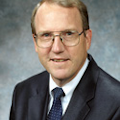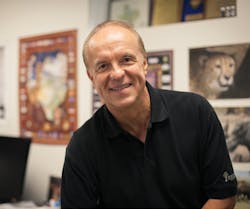New SEG chief sees broad contexts for data tools helping geophysical work
Conversation with Robert R. Stewart tends to veer toward broad contexts.
One minute, the incoming president of the Society of Exploration Geophysicists describes how big data and machine learning enhance arcane seismic methods to improve understanding of the subsurface. The next minute, he links those advances with the challenge of meeting energy needs of nearly 8 billion inhabitants of Planet Earth.
In an interview with Oil & Gas Journal, the University of Houston professor of exploration geophysics broadens context to assess his discipline.
“A challenge for geophysicists is that we like technology and analysis—squiggles, wiggles, migrations, inversions, and all that stuff,” he says. “But we also need to interpret, make sense of our pictures in economic terms, answering questions such as, ‘Is that presalt feature a promising reservoir? What’s the ultimate hydrocarbon recovery of the stimulated well? Are we monitoring production adequately to achieve the best results and safety?’”
Geophysics for the oil and gas industry, in Stewart’s view, aims “to make a great image of the subsurface and its fluids that’s easily interpretable and accurate,” meaning “a picture of the reservoir in depth with its key properties and how they change with production.”
Industry experience
Stewart speaks from experience in industry as well as academia. Early in his career, he worked with Chevron, ARCO, and Veritas Software and is now president of GENNIX Technology Inc. and Sonderra LLC. With a bachelor’s degree in physics from the University of Toronto and PhD in physics from the Massachusetts Institute of Technology, the Ontario native joined the University of Houston in 2008 after 21 years at the University of Calgary. He’s a full professor and the director of Allied Geophysical Labs—as well as a jazz saxophonist and licensed aircraft pilot.
Stewart describes modern geophysical progress in the context of managing exploding amounts of available data. In many cases, the data come through tools used in other industries. He mentions drones, distributed acoustic sensing (DAS) with fiber optics, and 3D printing. Geophysicists use 3D printing, a subset of additive manufacturing, for example, to test models and rocks.
“We can actually print a pretty good representation of a rock via scanning a real core, making all the measurements you can on it, and then fully reconstructing printed rocks from it,” Stewart says. “Then you can do physical experiments on the 3D models, such as flow or wave propagation, and have those replicated on identical models printed elsewhere in the world.”
Drones, or autonomous flying systems, increasingly fly geophysical missions, carrying airborne sensors and handling logistical chores such as placing geophones.
“If it’s dangerous, dirty, or has drudgery, we’d prefer a drone to do it,” the new SEG chief says. “Naturally, we’re trying to automate what we can. We’re working on applications from flying magnetometers over urban reclamation sites to find buried wellheads to designing transition-zone seismic surveying with swarms of hydrophone-carrying drones.”
Fiber-optic sensing
Another area of rapid development in seismic work is fiber-optic technology—with a new dimension. Traditional fiber optics uses coded laser pulses to convey information in one direction along a thin strand of glass. Geophysical work takes this further and interprets the reflections from fiber imperfections instead of using the transmitted light. Variations in reflected light indicate strain on the fiber, such as what might be caused by earth motion or temperature change.
“All of it comes down to stretching the fiber and bouncing light back from the distortions,” Stewart says, explaining that the fiber becomes a transducer converting motion into digital signal.
While the raw measurement is one-dimensional strain, he says, processing can determine whether strain results from arrival at the sensing location of compressional (P-wave) or transverse (S-wave) motion, a distinction useful in assessing rock properties during seismic interpretation.
Although fiber units are receivers, able to “listen” constantly for natural disturbances in the subsurface, they also can sense energy from the active sources used in conventional seismic work. Fiber can be installed in wellbores or on drillpipe or deployed like traditional seismic cables on land or in water.
“So you can start thinking about regular monitoring, daily monitoring, as well as hazard detection and resolution,” Stewart says. “For many geoscience and engineering applications, this is a game-changer.”
DAS helps other industries, too, he notes. “It works for security perimeters, pipelines, railways, anything where a physical deformation is of interest, for whatever reason.”
The geophysics division Stewart leads soon will attach a sensing unit to fiber unused by the university and, he says, “listen to the beating of the city’s heart.”
Broadening context further, Stewart adds, “We see it as potentially revolutionary to the whole world because there’s fiber under the oceans. In principal, all that fiber can be used as a strain sensor, not just a transmission network.”
“A challenge for geophysicists is that we like technology and analysis, but we also need to interpret, make sense of our pictures in economic terms.”—Robert R. Stewart
Big data, machine learning
With the availability of ever-greater amounts of data from ever-more sensing systems comes the need for massive computation and machine learning to put the information to practical use.
“You need big data to constrain the resolution and accuracy of the number of properties we’re looking for,” Stewart says. For every point in the subsurface, geophysicists examine multiple parameters, such as compressibility, density, cracks, porosity, and saturation.
“So we’ve got billions of subsurface points that we need to describe,” he points out. The aim is to model the subsurface with many parameters and compare the modeled result with observations.
For example, geophysicists use a technique called full-waveform inversion to model propagation of a seismic wave through the subsurface then iteratively compare it to real observations.
“You’re analyzing the full subsurface response as captured by arrays of motion sensors,” Stewart says, “and modeling every little piece of the received waveforms.” Waveform inversion essentially has the computer perform the many iterations needed to synthetically recreate a possible earth model and adjust assumptions to converge to results with data from actual geology.
“In the machine learning world, for different distributions, we do this hundreds of times—all synthetic, all in the computer,” Stewart says. “So the computer gets to know, ‘With this distribution of shots and receivers and geology, I can resolve this picture.’”
Once the computer “knows” what it can do with certain data, “you process your real survey. And it comes back, and it says, ‘Okay, I took your real results, I know what I can do with your survey and the likely background, and here’s the best picture I can give you.’”
But the process can’t end here. “Through all this, we don’t want to lose track of basic geology, basic rock properties, fundamental survey and analysis techniques because you still really want to make sure that you have posed the problem properly, interpreted the results within bounds, and you haven’t made egregious mistakes,” Stewart says. “So I don’t see that we are going to do away with ‘geopeople.’ You need human oversight and experience—and, of course, somebody has to come up with the ideas and write the code.”
License to operate
The new SEG president seamlessly transitions from geology and rock properties to the contribution geophysics can make to the oil and gas industry’s social license to operate.
Monitoring with DAS, for example, can enhance public acceptance of oil and gas projects by improving hazard preparedness.
“You can’t guarantee that nothing bad is going to happen, but you’ve got to be able to warrant that you’re on top of it, that you’re listening, monitoring, that you can remediate rapidly,” Stewart says, linking industry’s license to operate with the world’s growing energy needs.
“How do we continue to interact with the public so that we have reliable and inexpensive energy sources and the support to operate?” he asks—then offers suggestions: “We need to continue to educate—how much energy is now used, how it’s produced, what are actual footprints, what we’re doing to lower the impact of any energy source—through videos, talks, articles, and courses. Continue to undertake research: Imagine if we could somehow capture CO2 and economically turn it into limestone or something.
“We also need to turn some of our remarkable geoscience and engineering capabilities toward humanitarian purposes. SEG’s Geoscientists Without Borders is one program doing this (OGJ, Sept. 4, 2017, p. 52). The natural disaster impact is just getting larger and larger on account of more people and infrastructure.”
Citing Hurricane Harvey of 2017 and the devastation it inflicted around Corpus Christi with wind and in Houston with rainfall, Stewart says there was little problem when the area had severe weather 200 years ago. “Now, you’ve got 6 million people sitting in the Houston area alone. To nature, it’s perhaps a little rain; to us, it’s a big deal.”
Stewart sees “a major need and opportunity for our geo-organizations and energy groups to help in the hazard realm.” And help, he says, they must because the world and its people will continue to develop as well as need “enormous energy” for many years.
With global oil demand at nearly 100 million b/d, Stewart points out, “that’s slurping back a supergiant oil field a week.”
Again, he broadens context: “I think, for people who like development and like advancement and want to go to the stars, it’s ‘Bring on and evaluate every energy source you’ve got.’
“We’re getting out of our caves and cradles. We’re reaching out to the stars—a long journey, but I’m sure that we’ll make it with conscientious development of our energies.”
About the Author

Bob Tippee
Editor
Bob Tippee has been chief editor of Oil & Gas Journal since January 1999 and a member of the Journal staff since October 1977. Before joining the magazine, he worked as a reporter at the Tulsa World and served for four years as an officer in the US Air Force. A native of St. Louis, he holds a degree in journalism from the University of Tulsa.

